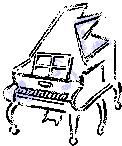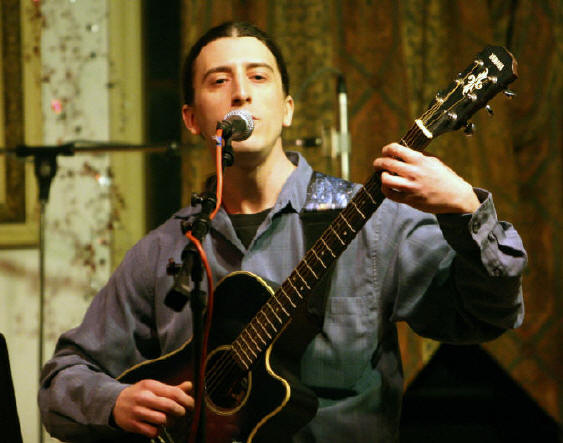Chapola Productions
Services: Recording Music Lessons Computer Lessons Parties
![]()
Chapola Music Lessons
Combining Tradition With Technology
Capital District, NY, USA
![]()
Teachers
![]()
![]()


Rates: $100/month paid one month in advance, 4 lessons/month, 45 minutes/lesson. We accept checks and/or cash. (No credit/debit cards.)
We give lessons in our home music studio, or if you prefer we can travel to your location for an extra fee of 50˘/mile ($5 minimum charge). For example, if you live 7 miles away, (14 mile round trip), we will charge $7/trip x 4 = $28/month extra. If 2 or more students are taking lessons at the same location, the driving fee is only charged once. If 2 or more families are taking lessons in the same neighborhood (scheduled in the same time frame), the driving fee can be split between the families.
Books: You can purchase all your Lesson Books directly from us. The cost to get you started is ~ $15-$30 depending on which course you take.
Practice & Homework: We assign written homework with every lesson. We expect you to practice the songs and drills we assign, and to complete and turn in all written homework on time.
Technique: We will teach you to focus on proper technique from the very beginning. Playing with proper technique will shorten the time it takes to advance in ability.
Rhythm: Music, just like your heartbeat, just like the Universe, has a pulse! We use a metronome and/or all the resources available in today's technology to help you learn to play with perfect rhythm.
Parents: Although not required, parents are encouraged to be involved in the whole process including the lessons. It is truly a team effort!
Productive & Fun: We make progress and have a good time while doing it!
You will only need 1 instrument to take lessons but it is preferable to have both.
| Piano (88 keys) If you have a piano you will also need a metronome, a piano lamp (or desk lamp) and a piano stool or an ergonomic bench (ergonomic meaning - correct height). Also it is recommended that you have your piano tuned at least once a year (~$99). |
| Keyboard (76 or 88 keys) If you have a keyboard you will NOT need a metronome as most keyboards already have them built in. You will need a piano lamp (or desk lamp), a piano stool or an ergonomic bench and eventually a sustain pedal. If you want to connect your keyboard to your computer you will need a USB cable. Most importantly, you will need a good, solid, height adjustable table, preferably with enough room in the back for a piano lamp and enough room on the side for music books. For example, these table dimensions would be ideal. |
| 76 Key Keyboard | Keyboard Table | |
| - Width: 49" | - Width: 60" | |
| - Depth: 17" | - Depth: 30" | |
| - Height: 4" (front of keyboard) | - Height: 24" | |
| Search on: Adjustable Height Rectangular Table 30" x 60" |
Additional material for solos, duets, and/or quartets will be offered to those interested in performing either solo and/or with other musicians at our Camp Fire Parties, Holiday Parties and other events.
Piano
Beginner songs like "Merrily We Roll Along" sound better on a keyboard than piano, thanks to all the special features like hundreds of different tones to choose from and especially the orchestral accompaniments (rhythm patterns). However it's important to note that playing with the rhythm patterns requires the same strict discipline as playing with the tick-tick-tick of a metronome, so the keyboard student will have as solid a foundation in rhythm, if not more, than the piano student. Since we'll still be using the same Lesson Books regardless of which instrument we're on, the keyboard students will be learning everything the piano student learns – and then some! That’s why we’re calling it - Piano Lessons Plus!
| Recording Station - you can record songs you play on multiple tracks and then later save them to a card and/or directly to your computer. This feature enables you, amongst other things, to practice, for example, one side of a duet while the other side is playing (on a separate track). Another advantage - you can control the speed of the song, giving it the same functionality as a metronome. |
| Headphone Jack - enables you to play your keyboard any time, even if others are watching TV, talking on the phone, sleeping, etc. You don't hear them and they don't hear you. |
| Tones - A piano has 1 tone: piano. A keyboard has hundreds of tones such as: Grand Piano, Electric Piano, Honky-Tonk Piano, Harpsichord, Glockenspiel, Music Box, Tubular Bells, Dulcimer, Organ, Electric Organ, Harmonica, Guitar, Violin, Cello, Harp, Strings, French Horn, Trumpet, Trombone, Tuba, Alto Sax, Oboe, Clarinet, Flute, Koto, Pi Pa, Shanai, Bag Pipe, Fiddle, Tinkle Bell, Melodic Tom, Wood Block, many more. |
| Sound Effects - such as raindrops, crystal, goblins, echoes, new age, seashore, birds, helicopters, applause, many more. |
| Rhythm Patterns - such as Piano Rock, Pop Rock, Funky Pop, R&R, Heavy Metal, R&B, Soul Ballad, Big Band, Swing, Polka, March, Bossa Nova, Rhumba, Mambo, Samba, Cha-Cha-Cha, French Waltz, Ball Waltz, Viennese Waltz, Tango, Merengue, Reggae, Gospel, Blues, Bluegrass, Country, 50's Ballad, Hawaiian, Boogie-Woogie, Ragtime, Piano Ballad, Arpeggio, many more. |
| MIDI - (Musical Instrument Digital Interface) If you have a MIDI keyboard and a computer you can connect your keyboard to the Internet and make 21st Century technology part of your lesson and music education! |
| Acoustic Guitars are about the same price as Electric Guitars, however if you choose Electric you will also have to buy an amplifier and cords (unless it has an amplifier built in). | |
| You will also need picks, a strap, and a music stand. |
| We will use the "Alfred's Basic Guitar Method" as the primary instruction book, including "Alfred's Basic Guitar Theory" which will be assigned as written homework. I will also teach some of my own drills to improve technique and finger strength. As you progress I will teach popular songs. If desired I will give you the opportunity to sing or play with other musicians. We will also spend some time learning to play by ear, and the art of improvisation. |
| Electric Guitars are easier to play in the beginning and you can plug them in. | |
| I prefer that my beginner students start with Acoustic Guitars. They are harder to play, thus greater finger strength and technique are developed from the beginning. Plus, if you want to play both types, it's easier to switch from Acoustic to Electric than the other way around. |
| For those who would like help in selecting and/or learning a song prior to recording. |
If you would like to learn more, call 518-399-1540, or send an email to
©2013 Chapola Productions
